Critical Analysis of Cryotherapy Research in Sports and Exercise
VerifiedAdded on 2020/04/21
|7
|1506
|426
Essay
AI Summary
This essay critically evaluates four research studies on cryotherapy and its application in sports and exercise. The studies explore the effects of cryotherapy on muscle temperature, the impact of different compression methods, the use of ice in acute injury management, and the effects of local tissue cooling on functional performance. The essay analyzes the strengths and limitations of each study, highlighting the practical implications for athletic trainers and athletes. Key findings include the effectiveness of elastic wraps for intramuscular cooling, the benefits of combining ice with compression, and the potential adverse effects of immediate cooling on athletic performance, suggesting the need for proper warm-up periods. The essay concludes by emphasizing the widespread acceptance of cryotherapy for sports injury treatment and the need for further research to refine its application.
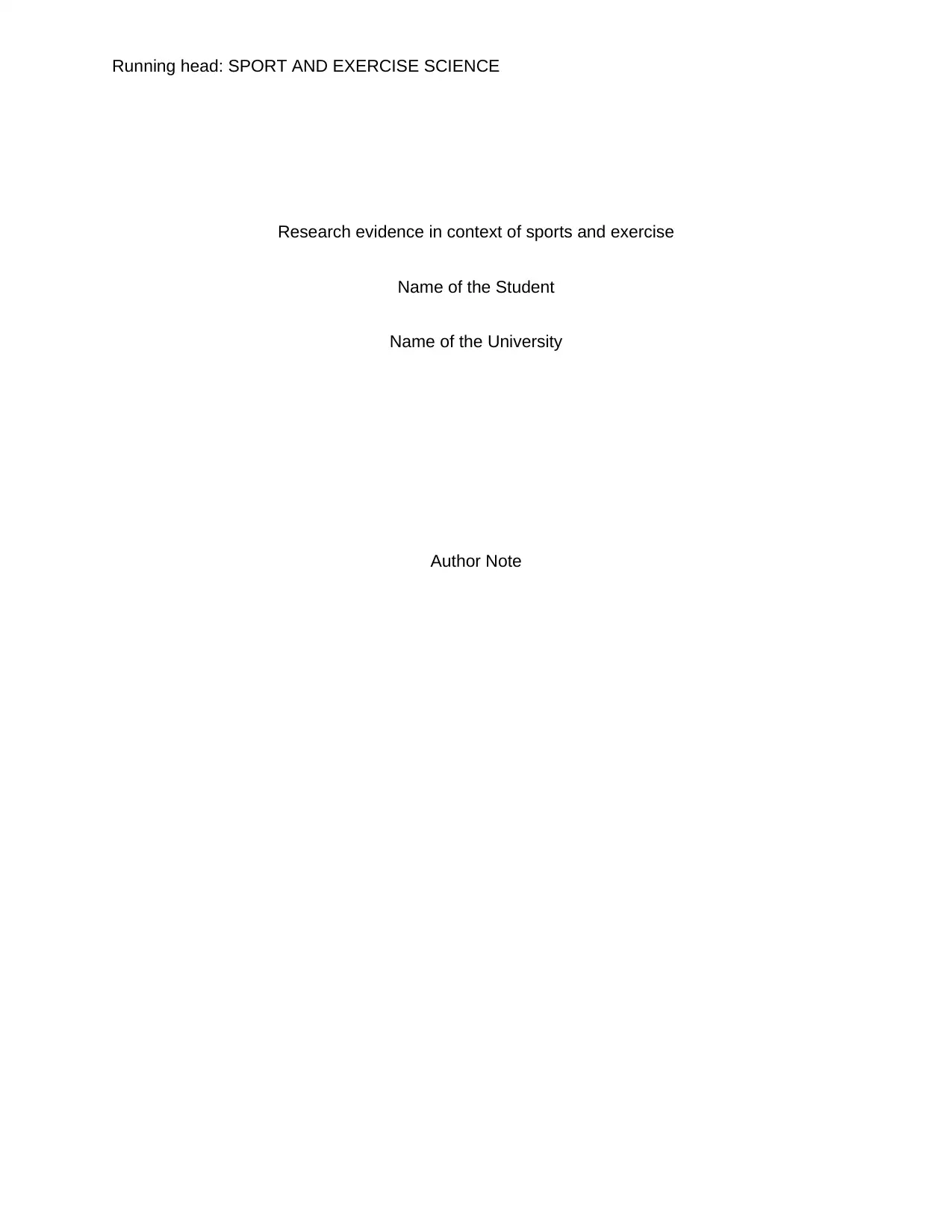
Running head: SPORT AND EXERCISE SCIENCE
Research evidence in context of sports and exercise
Name of the Student
Name of the University
Author Note
Research evidence in context of sports and exercise
Name of the Student
Name of the University
Author Note
Paraphrase This Document
Need a fresh take? Get an instant paraphrase of this document with our AI Paraphraser
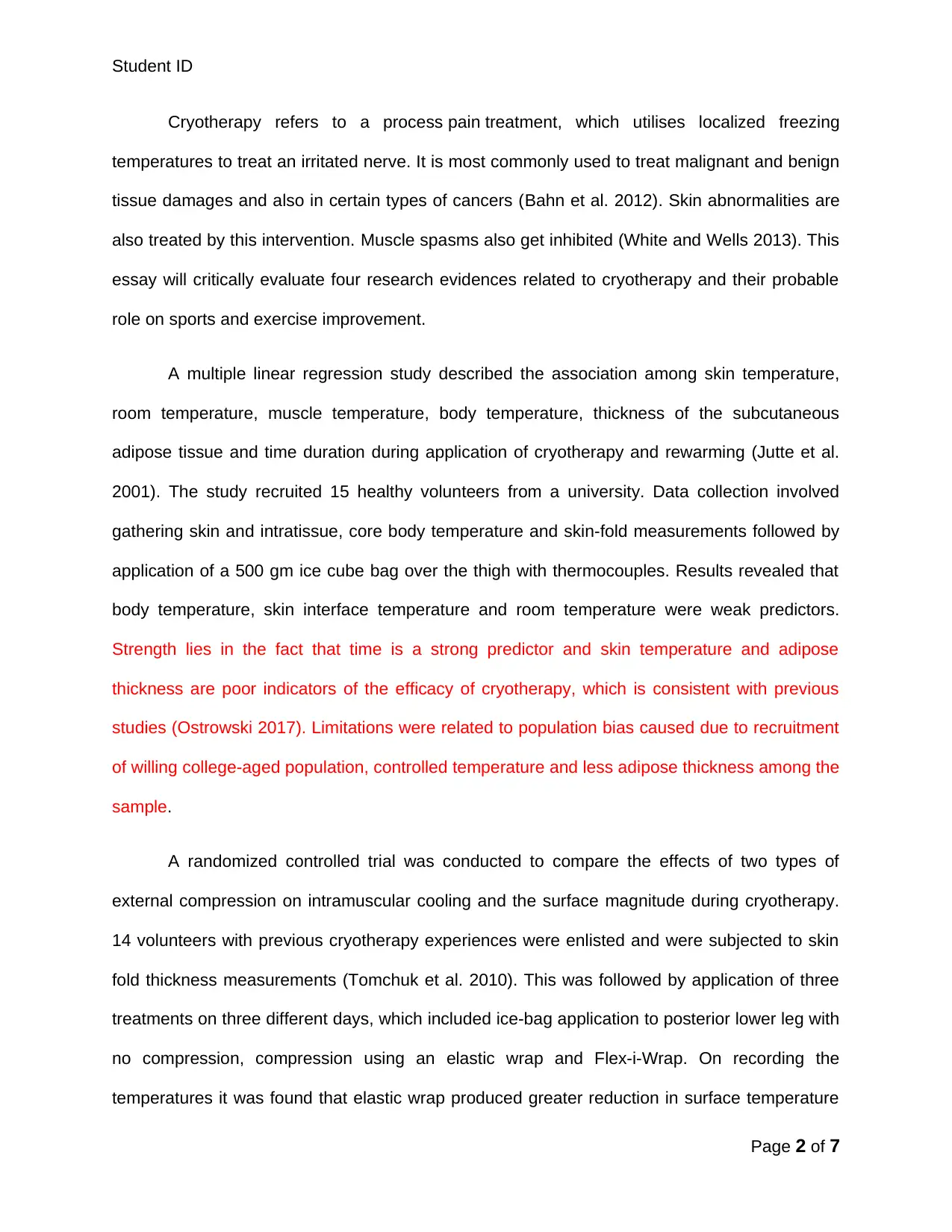
Student ID
Cryotherapy refers to a process pain treatment, which utilises localized freezing
temperatures to treat an irritated nerve. It is most commonly used to treat malignant and benign
tissue damages and also in certain types of cancers (Bahn et al. 2012). Skin abnormalities are
also treated by this intervention. Muscle spasms also get inhibited (White and Wells 2013). This
essay will critically evaluate four research evidences related to cryotherapy and their probable
role on sports and exercise improvement.
A multiple linear regression study described the association among skin temperature,
room temperature, muscle temperature, body temperature, thickness of the subcutaneous
adipose tissue and time duration during application of cryotherapy and rewarming (Jutte et al.
2001). The study recruited 15 healthy volunteers from a university. Data collection involved
gathering skin and intratissue, core body temperature and skin-fold measurements followed by
application of a 500 gm ice cube bag over the thigh with thermocouples. Results revealed that
body temperature, skin interface temperature and room temperature were weak predictors.
Strength lies in the fact that time is a strong predictor and skin temperature and adipose
thickness are poor indicators of the efficacy of cryotherapy, which is consistent with previous
studies (Ostrowski 2017). Limitations were related to population bias caused due to recruitment
of willing college-aged population, controlled temperature and less adipose thickness among the
sample.
A randomized controlled trial was conducted to compare the effects of two types of
external compression on intramuscular cooling and the surface magnitude during cryotherapy.
14 volunteers with previous cryotherapy experiences were enlisted and were subjected to skin
fold thickness measurements (Tomchuk et al. 2010). This was followed by application of three
treatments on three different days, which included ice-bag application to posterior lower leg with
no compression, compression using an elastic wrap and Flex-i-Wrap. On recording the
temperatures it was found that elastic wrap produced greater reduction in surface temperature
Page 2 of 7
Cryotherapy refers to a process pain treatment, which utilises localized freezing
temperatures to treat an irritated nerve. It is most commonly used to treat malignant and benign
tissue damages and also in certain types of cancers (Bahn et al. 2012). Skin abnormalities are
also treated by this intervention. Muscle spasms also get inhibited (White and Wells 2013). This
essay will critically evaluate four research evidences related to cryotherapy and their probable
role on sports and exercise improvement.
A multiple linear regression study described the association among skin temperature,
room temperature, muscle temperature, body temperature, thickness of the subcutaneous
adipose tissue and time duration during application of cryotherapy and rewarming (Jutte et al.
2001). The study recruited 15 healthy volunteers from a university. Data collection involved
gathering skin and intratissue, core body temperature and skin-fold measurements followed by
application of a 500 gm ice cube bag over the thigh with thermocouples. Results revealed that
body temperature, skin interface temperature and room temperature were weak predictors.
Strength lies in the fact that time is a strong predictor and skin temperature and adipose
thickness are poor indicators of the efficacy of cryotherapy, which is consistent with previous
studies (Ostrowski 2017). Limitations were related to population bias caused due to recruitment
of willing college-aged population, controlled temperature and less adipose thickness among the
sample.
A randomized controlled trial was conducted to compare the effects of two types of
external compression on intramuscular cooling and the surface magnitude during cryotherapy.
14 volunteers with previous cryotherapy experiences were enlisted and were subjected to skin
fold thickness measurements (Tomchuk et al. 2010). This was followed by application of three
treatments on three different days, which included ice-bag application to posterior lower leg with
no compression, compression using an elastic wrap and Flex-i-Wrap. On recording the
temperatures it was found that elastic wrap produced greater reduction in surface temperature
Page 2 of 7
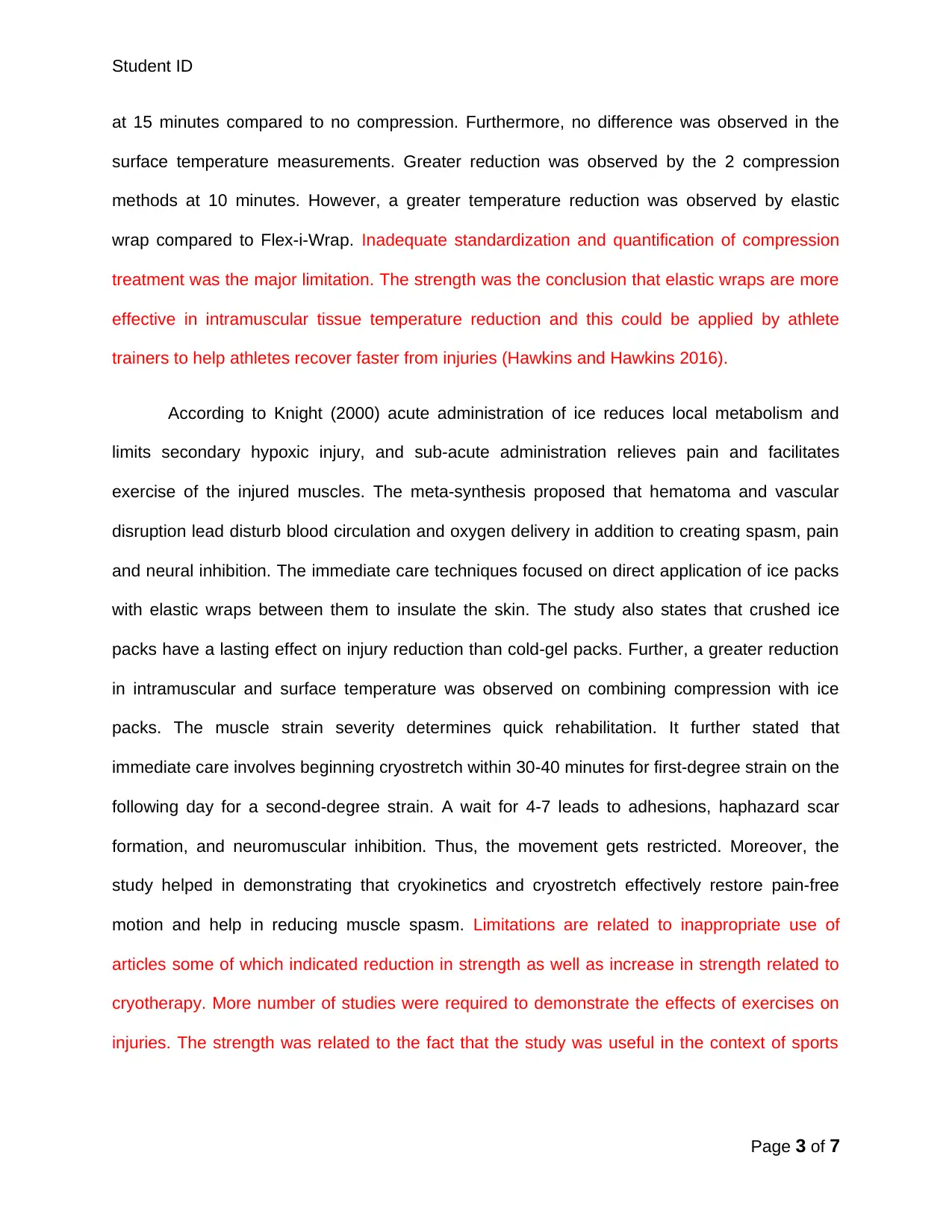
Student ID
at 15 minutes compared to no compression. Furthermore, no difference was observed in the
surface temperature measurements. Greater reduction was observed by the 2 compression
methods at 10 minutes. However, a greater temperature reduction was observed by elastic
wrap compared to Flex-i-Wrap. Inadequate standardization and quantification of compression
treatment was the major limitation. The strength was the conclusion that elastic wraps are more
effective in intramuscular tissue temperature reduction and this could be applied by athlete
trainers to help athletes recover faster from injuries (Hawkins and Hawkins 2016).
According to Knight (2000) acute administration of ice reduces local metabolism and
limits secondary hypoxic injury, and sub-acute administration relieves pain and facilitates
exercise of the injured muscles. The meta-synthesis proposed that hematoma and vascular
disruption lead disturb blood circulation and oxygen delivery in addition to creating spasm, pain
and neural inhibition. The immediate care techniques focused on direct application of ice packs
with elastic wraps between them to insulate the skin. The study also states that crushed ice
packs have a lasting effect on injury reduction than cold-gel packs. Further, a greater reduction
in intramuscular and surface temperature was observed on combining compression with ice
packs. The muscle strain severity determines quick rehabilitation. It further stated that
immediate care involves beginning cryostretch within 30-40 minutes for first-degree strain on the
following day for a second-degree strain. A wait for 4-7 leads to adhesions, haphazard scar
formation, and neuromuscular inhibition. Thus, the movement gets restricted. Moreover, the
study helped in demonstrating that cryokinetics and cryostretch effectively restore pain-free
motion and help in reducing muscle spasm. Limitations are related to inappropriate use of
articles some of which indicated reduction in strength as well as increase in strength related to
cryotherapy. More number of studies were required to demonstrate the effects of exercises on
injuries. The strength was related to the fact that the study was useful in the context of sports
Page 3 of 7
at 15 minutes compared to no compression. Furthermore, no difference was observed in the
surface temperature measurements. Greater reduction was observed by the 2 compression
methods at 10 minutes. However, a greater temperature reduction was observed by elastic
wrap compared to Flex-i-Wrap. Inadequate standardization and quantification of compression
treatment was the major limitation. The strength was the conclusion that elastic wraps are more
effective in intramuscular tissue temperature reduction and this could be applied by athlete
trainers to help athletes recover faster from injuries (Hawkins and Hawkins 2016).
According to Knight (2000) acute administration of ice reduces local metabolism and
limits secondary hypoxic injury, and sub-acute administration relieves pain and facilitates
exercise of the injured muscles. The meta-synthesis proposed that hematoma and vascular
disruption lead disturb blood circulation and oxygen delivery in addition to creating spasm, pain
and neural inhibition. The immediate care techniques focused on direct application of ice packs
with elastic wraps between them to insulate the skin. The study also states that crushed ice
packs have a lasting effect on injury reduction than cold-gel packs. Further, a greater reduction
in intramuscular and surface temperature was observed on combining compression with ice
packs. The muscle strain severity determines quick rehabilitation. It further stated that
immediate care involves beginning cryostretch within 30-40 minutes for first-degree strain on the
following day for a second-degree strain. A wait for 4-7 leads to adhesions, haphazard scar
formation, and neuromuscular inhibition. Thus, the movement gets restricted. Moreover, the
study helped in demonstrating that cryokinetics and cryostretch effectively restore pain-free
motion and help in reducing muscle spasm. Limitations are related to inappropriate use of
articles some of which indicated reduction in strength as well as increase in strength related to
cryotherapy. More number of studies were required to demonstrate the effects of exercises on
injuries. The strength was related to the fact that the study was useful in the context of sports
Page 3 of 7
⊘ This is a preview!⊘
Do you want full access?
Subscribe today to unlock all pages.

Trusted by 1+ million students worldwide
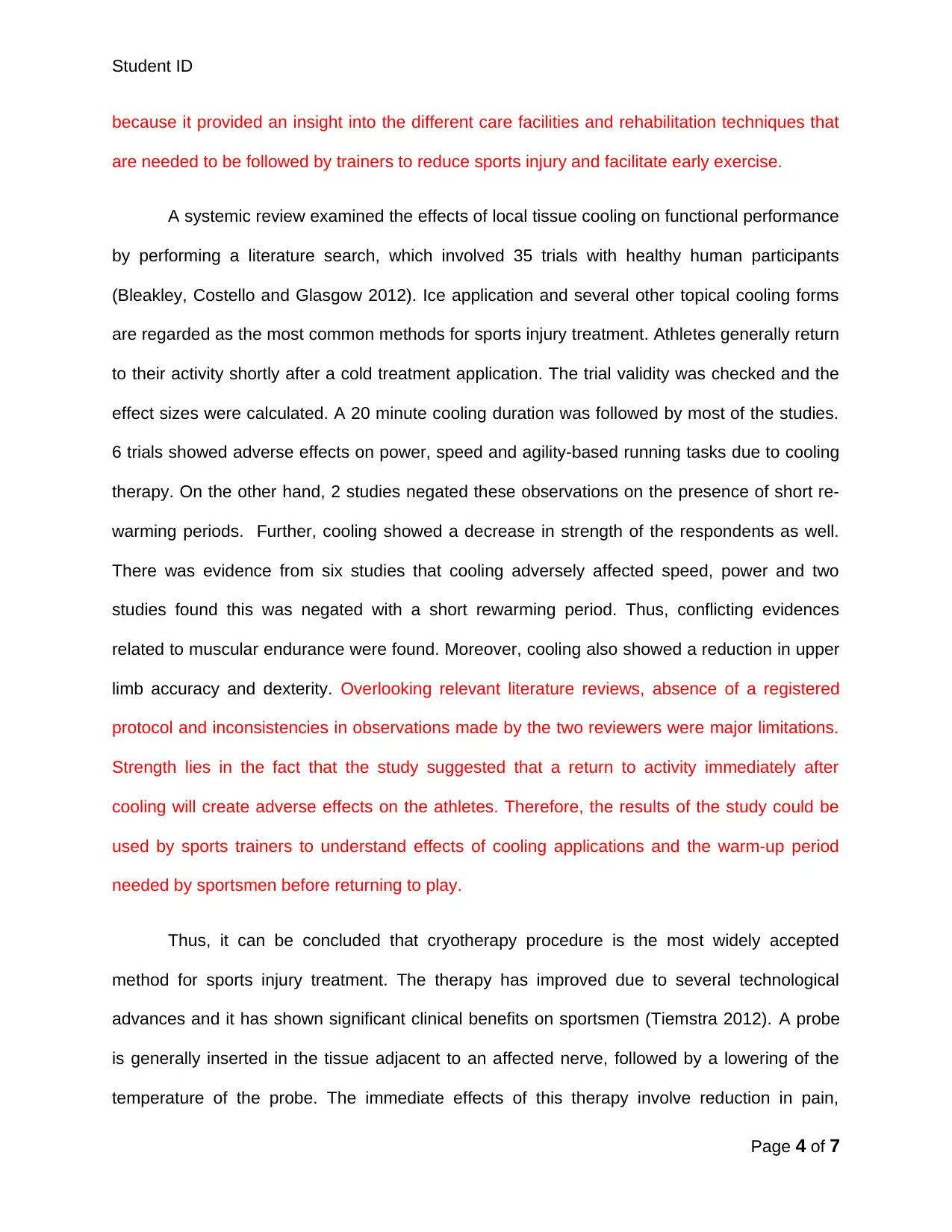
Student ID
because it provided an insight into the different care facilities and rehabilitation techniques that
are needed to be followed by trainers to reduce sports injury and facilitate early exercise.
A systemic review examined the effects of local tissue cooling on functional performance
by performing a literature search, which involved 35 trials with healthy human participants
(Bleakley, Costello and Glasgow 2012). Ice application and several other topical cooling forms
are regarded as the most common methods for sports injury treatment. Athletes generally return
to their activity shortly after a cold treatment application. The trial validity was checked and the
effect sizes were calculated. A 20 minute cooling duration was followed by most of the studies.
6 trials showed adverse effects on power, speed and agility-based running tasks due to cooling
therapy. On the other hand, 2 studies negated these observations on the presence of short re-
warming periods. Further, cooling showed a decrease in strength of the respondents as well.
There was evidence from six studies that cooling adversely affected speed, power and two
studies found this was negated with a short rewarming period. Thus, conflicting evidences
related to muscular endurance were found. Moreover, cooling also showed a reduction in upper
limb accuracy and dexterity. Overlooking relevant literature reviews, absence of a registered
protocol and inconsistencies in observations made by the two reviewers were major limitations.
Strength lies in the fact that the study suggested that a return to activity immediately after
cooling will create adverse effects on the athletes. Therefore, the results of the study could be
used by sports trainers to understand effects of cooling applications and the warm-up period
needed by sportsmen before returning to play.
Thus, it can be concluded that cryotherapy procedure is the most widely accepted
method for sports injury treatment. The therapy has improved due to several technological
advances and it has shown significant clinical benefits on sportsmen (Tiemstra 2012). A probe
is generally inserted in the tissue adjacent to an affected nerve, followed by a lowering of the
temperature of the probe. The immediate effects of this therapy involve reduction in pain,
Page 4 of 7
because it provided an insight into the different care facilities and rehabilitation techniques that
are needed to be followed by trainers to reduce sports injury and facilitate early exercise.
A systemic review examined the effects of local tissue cooling on functional performance
by performing a literature search, which involved 35 trials with healthy human participants
(Bleakley, Costello and Glasgow 2012). Ice application and several other topical cooling forms
are regarded as the most common methods for sports injury treatment. Athletes generally return
to their activity shortly after a cold treatment application. The trial validity was checked and the
effect sizes were calculated. A 20 minute cooling duration was followed by most of the studies.
6 trials showed adverse effects on power, speed and agility-based running tasks due to cooling
therapy. On the other hand, 2 studies negated these observations on the presence of short re-
warming periods. Further, cooling showed a decrease in strength of the respondents as well.
There was evidence from six studies that cooling adversely affected speed, power and two
studies found this was negated with a short rewarming period. Thus, conflicting evidences
related to muscular endurance were found. Moreover, cooling also showed a reduction in upper
limb accuracy and dexterity. Overlooking relevant literature reviews, absence of a registered
protocol and inconsistencies in observations made by the two reviewers were major limitations.
Strength lies in the fact that the study suggested that a return to activity immediately after
cooling will create adverse effects on the athletes. Therefore, the results of the study could be
used by sports trainers to understand effects of cooling applications and the warm-up period
needed by sportsmen before returning to play.
Thus, it can be concluded that cryotherapy procedure is the most widely accepted
method for sports injury treatment. The therapy has improved due to several technological
advances and it has shown significant clinical benefits on sportsmen (Tiemstra 2012). A probe
is generally inserted in the tissue adjacent to an affected nerve, followed by a lowering of the
temperature of the probe. The immediate effects of this therapy involve reduction in pain,
Page 4 of 7
Paraphrase This Document
Need a fresh take? Get an instant paraphrase of this document with our AI Paraphraser
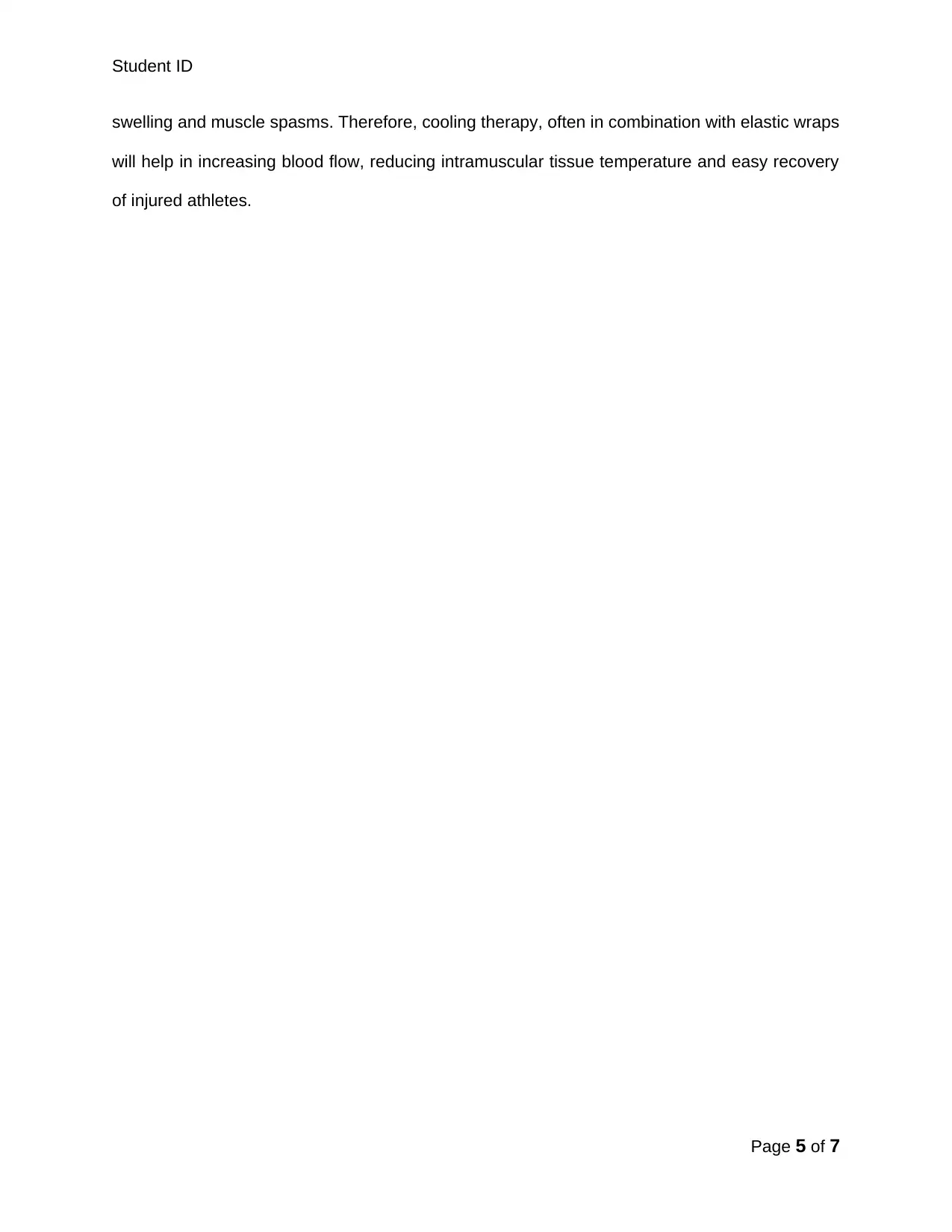
Student ID
swelling and muscle spasms. Therefore, cooling therapy, often in combination with elastic wraps
will help in increasing blood flow, reducing intramuscular tissue temperature and easy recovery
of injured athletes.
Page 5 of 7
swelling and muscle spasms. Therefore, cooling therapy, often in combination with elastic wraps
will help in increasing blood flow, reducing intramuscular tissue temperature and easy recovery
of injured athletes.
Page 5 of 7
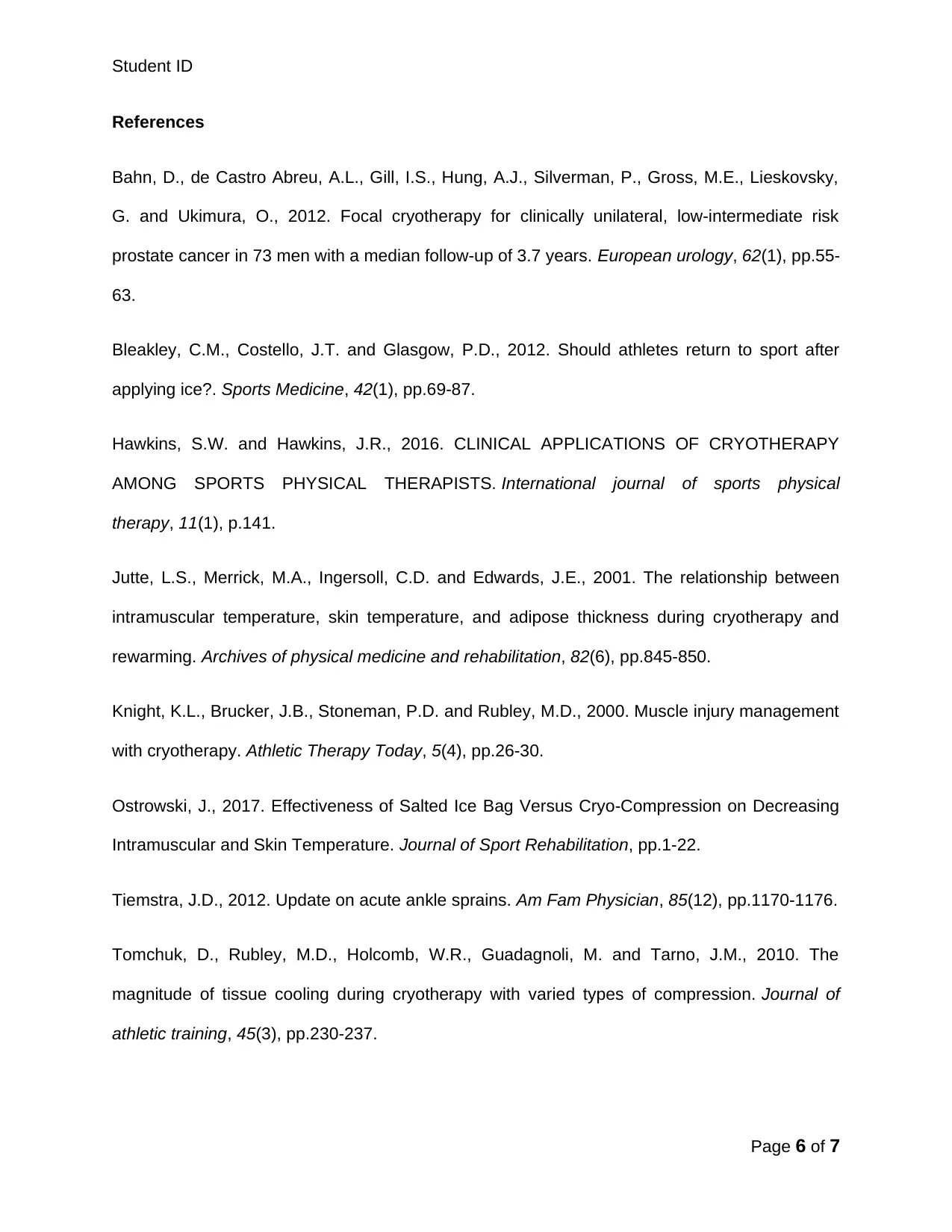
Student ID
References
Bahn, D., de Castro Abreu, A.L., Gill, I.S., Hung, A.J., Silverman, P., Gross, M.E., Lieskovsky,
G. and Ukimura, O., 2012. Focal cryotherapy for clinically unilateral, low-intermediate risk
prostate cancer in 73 men with a median follow-up of 3.7 years. European urology, 62(1), pp.55-
63.
Bleakley, C.M., Costello, J.T. and Glasgow, P.D., 2012. Should athletes return to sport after
applying ice?. Sports Medicine, 42(1), pp.69-87.
Hawkins, S.W. and Hawkins, J.R., 2016. CLINICAL APPLICATIONS OF CRYOTHERAPY
AMONG SPORTS PHYSICAL THERAPISTS. International journal of sports physical
therapy, 11(1), p.141.
Jutte, L.S., Merrick, M.A., Ingersoll, C.D. and Edwards, J.E., 2001. The relationship between
intramuscular temperature, skin temperature, and adipose thickness during cryotherapy and
rewarming. Archives of physical medicine and rehabilitation, 82(6), pp.845-850.
Knight, K.L., Brucker, J.B., Stoneman, P.D. and Rubley, M.D., 2000. Muscle injury management
with cryotherapy. Athletic Therapy Today, 5(4), pp.26-30.
Ostrowski, J., 2017. Effectiveness of Salted Ice Bag Versus Cryo-Compression on Decreasing
Intramuscular and Skin Temperature. Journal of Sport Rehabilitation, pp.1-22.
Tiemstra, J.D., 2012. Update on acute ankle sprains. Am Fam Physician, 85(12), pp.1170-1176.
Tomchuk, D., Rubley, M.D., Holcomb, W.R., Guadagnoli, M. and Tarno, J.M., 2010. The
magnitude of tissue cooling during cryotherapy with varied types of compression. Journal of
athletic training, 45(3), pp.230-237.
Page 6 of 7
References
Bahn, D., de Castro Abreu, A.L., Gill, I.S., Hung, A.J., Silverman, P., Gross, M.E., Lieskovsky,
G. and Ukimura, O., 2012. Focal cryotherapy for clinically unilateral, low-intermediate risk
prostate cancer in 73 men with a median follow-up of 3.7 years. European urology, 62(1), pp.55-
63.
Bleakley, C.M., Costello, J.T. and Glasgow, P.D., 2012. Should athletes return to sport after
applying ice?. Sports Medicine, 42(1), pp.69-87.
Hawkins, S.W. and Hawkins, J.R., 2016. CLINICAL APPLICATIONS OF CRYOTHERAPY
AMONG SPORTS PHYSICAL THERAPISTS. International journal of sports physical
therapy, 11(1), p.141.
Jutte, L.S., Merrick, M.A., Ingersoll, C.D. and Edwards, J.E., 2001. The relationship between
intramuscular temperature, skin temperature, and adipose thickness during cryotherapy and
rewarming. Archives of physical medicine and rehabilitation, 82(6), pp.845-850.
Knight, K.L., Brucker, J.B., Stoneman, P.D. and Rubley, M.D., 2000. Muscle injury management
with cryotherapy. Athletic Therapy Today, 5(4), pp.26-30.
Ostrowski, J., 2017. Effectiveness of Salted Ice Bag Versus Cryo-Compression on Decreasing
Intramuscular and Skin Temperature. Journal of Sport Rehabilitation, pp.1-22.
Tiemstra, J.D., 2012. Update on acute ankle sprains. Am Fam Physician, 85(12), pp.1170-1176.
Tomchuk, D., Rubley, M.D., Holcomb, W.R., Guadagnoli, M. and Tarno, J.M., 2010. The
magnitude of tissue cooling during cryotherapy with varied types of compression. Journal of
athletic training, 45(3), pp.230-237.
Page 6 of 7
⊘ This is a preview!⊘
Do you want full access?
Subscribe today to unlock all pages.

Trusted by 1+ million students worldwide
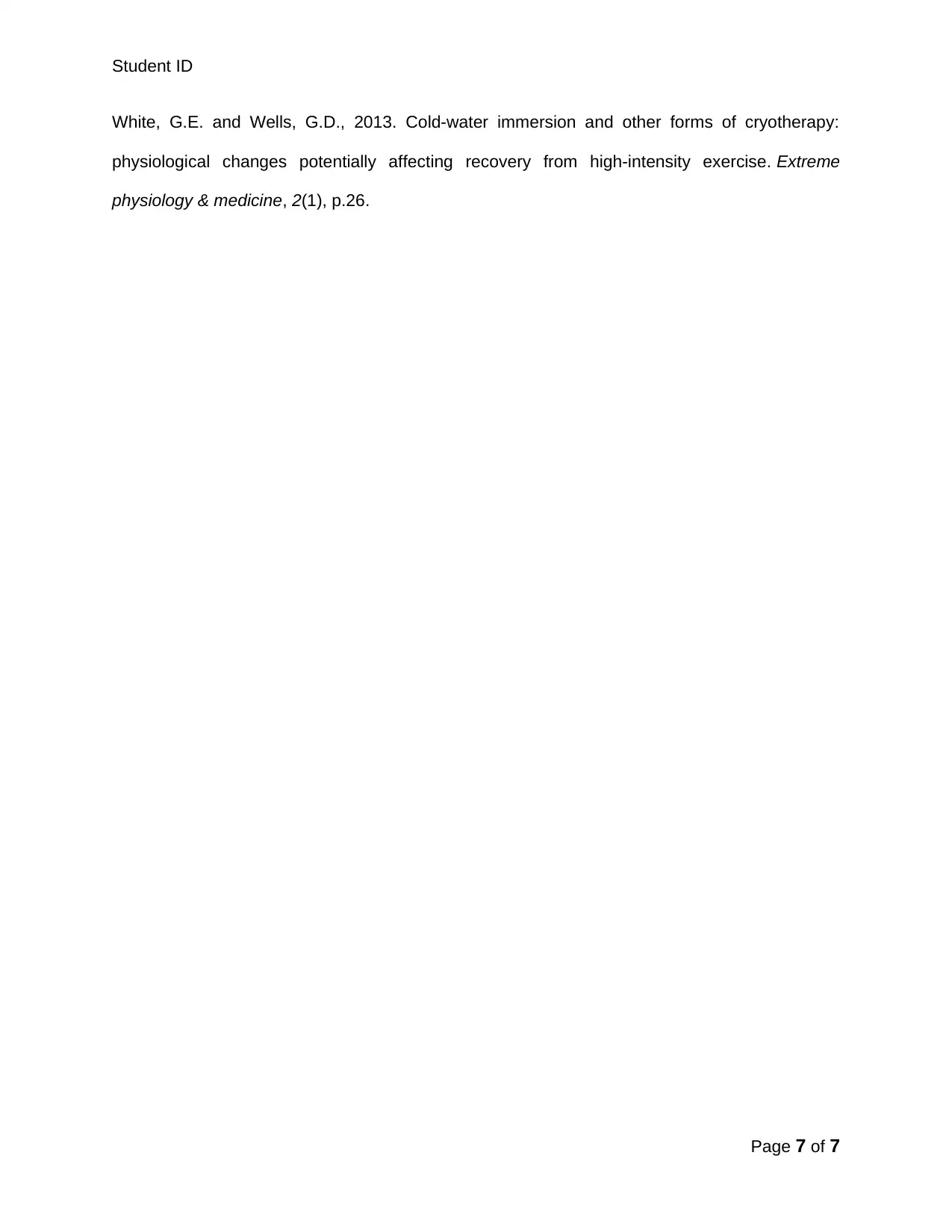
Student ID
White, G.E. and Wells, G.D., 2013. Cold-water immersion and other forms of cryotherapy:
physiological changes potentially affecting recovery from high-intensity exercise. Extreme
physiology & medicine, 2(1), p.26.
Page 7 of 7
White, G.E. and Wells, G.D., 2013. Cold-water immersion and other forms of cryotherapy:
physiological changes potentially affecting recovery from high-intensity exercise. Extreme
physiology & medicine, 2(1), p.26.
Page 7 of 7
1 out of 7
Your All-in-One AI-Powered Toolkit for Academic Success.
+13062052269
info@desklib.com
Available 24*7 on WhatsApp / Email
![[object Object]](/_next/static/media/star-bottom.7253800d.svg)
Unlock your academic potential
Copyright © 2020–2025 A2Z Services. All Rights Reserved. Developed and managed by ZUCOL.